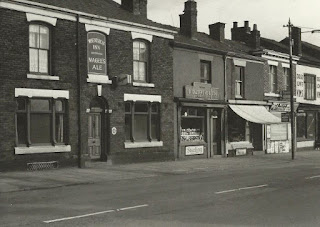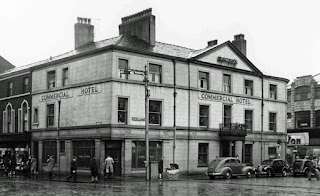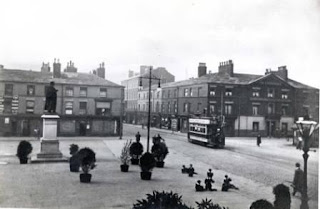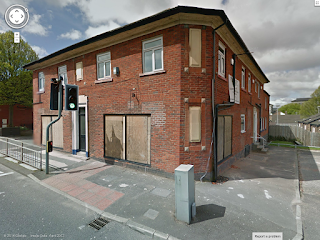The Bush Hotel –
formerly the Star and before that the Cock Inn - on Churchgate
pictured in 1938. The Bush is in front of Theatre Royal’s canopy as
we look. The Venue currently stands on the site.
The music hall was the
most popular form of mass entertainment for the working-class public
of Britain in the nineteenth century. In his book Popular Leisure And
The Music Hall in 19th century Bolton written in 1982, Robert Poole
claims the first music hall in Britain was at the Millstone on Crown
Street in Bolton where landlord Thomas Sharples opened a singing and
supper room around 1830. That claim has been challenged by some who
believe the music hall began in London at least two years earlier or
that its origins were in the coffee taverns of the late-18th
century. Even so, music hall didn't become a cultural phenomenon
until around 1850 by which time Thomas Sharples had been in business
in Bolton for 20 years. It has been claimed that Sharples was once a
ventriloquist travelling from pub to pub with his dummy before he
took over the Millstone (Moran family reminiscences, Bolton Evening
News, 25 April 1882).
The Millstone still
exists today and given the size of the pub – twice the size now as
it was before it was extended in 2000 - such a supper room can only
have been held upstairs.
No doubt the size of
the Millstone hindered Thomas Sharples and his ambitions. Bolton's
centre was Churchgate and we know that by 1838 Sharples had also
taken on the Cock, a pub that had existed since at least the 1770s
and allegedly got its name from the cock fights held there. It was a
little more genteel by now and it was popular with churchgoers who
would dine there on a Sunday lunchtime after attending service at the
nearby Parish Church.
The Bolton Chronicle of
4 August 1838 reported that the Albion Lodge No. 46 of the United Odd
Fellows held their annual dinner at the pub - “an excellent dinner
provided by the worthy host and hostess, Mr and Mrs Sharples.”
However, not all
functions held at the Cock were as civilised as the Odd Fellows. The
Bolton Chronicle of 6 July 1839 reported that Robert Ogden was
charged with being disorderly and indecently assaulting a number of
females at the pub. The incident happened during a christening when
Ogden introduced himself into the assembled company and, as the paper
put it “took indecent liberties,” with some of the females. “To
preserve their chastity he was given into custody.” He was fined 20
shillings (£1) plus costs.
By June 1840, the Cock
had become the Star and Thomas Sharples laid the corner stone for the
new music room. Ever the showman he put on a ceremony in order to
extract the maximum publicity with singers performing the national
anthem prior to coins from the reigns of George II, George III,
George IV, William IV and Queen Victoria all being deposited beneath
the stone.
The Bolton Chronicle
was impressed. In its edition of 13 June 1840, the paper said:
“This room, we
understand, when completed, is intended as a lounge, music room and
museum, and in addition to a great number of interesting and valuable
curiosities, will be the repository of Mr Sharples's valuable
selection of paintings. For size, we believe it will exceed any other
room in the town.”
The Chronicle kept its
readers abreast of progress and on 9 September 1840 it gushed at the
show Sharples put on for the opening night of the Star's music room.
“It was enrapturing beyond conception,” said the paper.
Even the transfer two
months later of two Oddfellow lodges, “Welcome Traveller” and
“Orthodox”, from the Millstone, was accompanied by a show.
Members of the two lodges walked in procession the short distance
from the Millstone to the Star and as they approached the pub Thomas
Sharples set off fireworks to welcome them. Mrs Sharples then put on
a meal for no fewer than 300 people.
Like many music halls
and concert room there were a variety of acts, some of which involved
wild animals. On 11 February 1844, Matthew Ferguson, the keeper of
the menagerie, was killed by Barney, one of the Star’s leopards.
One version claims that Barney didn’t take too kindly to Ferguson’s
liberal use of the whip and attacked the keeper. Some 28 years later,
on 4 January 1872, the Bolton Evening News made reference to the
incident but put a different spin on the circumstances. It claimed
Ferguson had had a drink and decided to play with Barney at which
point the animal turned on him and mauled him to death. There was
no-one else present at the time. Ferguson was discovered some time
later with Barney standing over him and moaning. Thomas Sharples had
Barney destroyed and the animal was stuffed before being put on
display in the pub's museum.
Sharples was refused a
licence to put on theatrical performances so the entertainment was of
the kind that would typify music hall for the next 70 years or so. A
programme from 1845 detailed F A Canfield, the American Samson and
wonder of the world, the Southern Minstrels, and gymnastic
pantomimists Nunn, Walker, Honey and Steward.
Such was the fame of
the Star that Thomas Sharples put on a special train from Manchester
in September 1845. Patrons could enjoy a trip to Bolton where they
could take in the curiosities of the Star's museum followed by a
concert in the saloon “and all for the small charge of a shilling,”
he told the Bolton Chronicle.
In July 1852 three
people were killed following the collapse of one of the walls in the
Star’s concert room. A fire six days earlier had made the wall
unsafe and it was in the process of being demolished when it
collapsed on to some cottages in nearby Wigan Lane. The inhabitants
of Wigan Lane were, as the Bolton Chronicle of 24 July 1852 put it:
“Irish people of the lowest orders” and the buildings were
inhabited almost to the point of overcrowding. Michael Larkin, whose
age was given as between 40 and 50, Mary Curley aged 38, and a
ten-year-old child, Nabby Kilgallen, all died having been buried by
the collapsed wall, Michael Larkin had been eating his breakfast,
Mary Curley had been outside in Wigan Lane and Nabby Kilgallen was in
bed. The collapse happened at ten o'clock in the morning, a time when
the vast majority of the inhabitants of Wigan Lane were out at work
thereby avoiding a greater death toll. A verdict of accidental death
was passed by the jury at an inquest the same evening. Most of the
cottages in Wigan Lane were destroyed and the other inhabitants were
rehoused by the authorities.
At that stage the Star
had the reputation of being one of the most popular and attractive
concert rooms in the country. It also contained a museum the wonders
of which were famed far and wide – 262 items including paintings,
wax figures and a piece of pressed iron from Hick’s foundry on
Bridgeman Street. Most were destroyed along with the stuffed effigy
of Barney the tiger.
William Sharples had by
now taken over the business from his father. Thomas Sharples retired
to a house on Chorley New Road where he died in 1853, aged 50.
A month after the
collapse of the wall, in August 1852, William Sharples tried to sell
the Star, but those efforts were affected by the decision of local
magistrates to suspend the licences of both the Star and the
Millstone. Without a licence the Star was much less of an attraction
to would-be purchasers. When it came up for auction it failed to
realise its reserve price of £1100 and was withdrawn from sale. The
month after the auction, in October 1852, both the Star and the
Millstone regained their licences.
The Star's vaults were
still open but the site of the former music room was empty. William
Sharples offered to build a room on site to be used by the council as
a library, but the offer was rejected.
In 1861, William
Sharples bought the axe that was reputedly
used in the beheading of the Earl of Derby outside the Man and Scythe
in 1651. He died in July the following year aged 38. His widow Ruth
Rigg Sharples died four months later aged just 30.
More on the axe here.
William Sharples
remained at the Star until his death. His estate of £6000 would be
worth around £700,000 today so the pub game had been good to him.
For the next seven years it was run by a relative, John Smith, but by
1870 it was in the hands of a man who did much to bring back the
glory days of the Star: J. P. Weston.
James Pitney was born
in Somerton, Somerset, in 1831. He got into the entertainment
industry while still a teenager. Indeed, the 1851 Census has him
living with his family at Shoreditch, Middlesex – occupation:
“clown”. By 1857 he was using the name James Pitney Weston. That
Christmas he played the clown in a comic pantomime at the Theatre
Royal, Norwich, and was credited with arranging the comic scenes.
Reviews of the time described him as "the Clown of all Nations".
From 1870 Weston was
initially the lessee of the Star, but in 1872 he bought the pub, its
concert hall, the nearby Angel Inn and the Theatre Royal for £4900.
Bolton's theatreland
evokes images of something akin to London's West End but it was
nothing of the sort. In 1871, a barman at the Star abducted Christine
Masper, a girl under the age of 16. He was sentenced to three months
imprisonment although as the Bolton Evening News pointed out in its
issue of 14 March 1871, had she been the heiress to any money or
property, he would have received between three and 14 years' penal
servitude.
The attached Angel Inn
was part of a betting scandal in 1873 which found the Star's manager
Robert Blake in court. There was also an attempt to remove the
licences of both the Star and the Angel in 1873 as part of a
Victorian crackdown on anything that might be considered immoral.
That included bawdy music hall songs. Fortunately, the police were on
Weston's side and he escaped without censure.
Weston only ran the
Star for seven years, from 1870 to 1877. However, he over-stretched
himself financially not so much in Bolton but elsewhere. He also
owned a number of other theatres in the north-west including the
Liverpool Palace Of Varieties which he renamed the New Albert Theatre
and where he appeared himself as Hamlet in 1874. He also bought the
rights to London dramas and adapted them for his own theatres. (See
An Illustrated History of British Theatre and Performance: Volume
Two - From the Industrial Revolution to the Digital Age by Robert
Leach, published by Routledge, 2018).
In 1877 Weston decided
to sell his Bolton properties. He moved to Dawes Street where he
oversaw the conversion of the former Temple Mill to the Temple Opera
House. He was forced to deny claims he was going to America but in
May 1878 James Pitney Weston was declared bankrupt. The order was
later annulled but it was the end of his time as an impressario.
Weston moved to the Rochdale area and he was lodging with the
Swindells family by 1881. His wife Mary Ann died in 1884 but Weston
remarried in 1890. He married 23-year-old Rose Emily Pannett in
Salford declaring his own age to be 55. In reality he was at least
four years older. He described himself at that time as a caterer.
The Bolton Evening News
of 29 October 1902 announced the death of James Pitney Weston in
Leeds the previous night. The paper admitted he'd had “a chequered
career” since he left Bolton. Weston would have been 71 years old
at the time of his death and he was employed by Messrs Dotteridge and
Longton, theatrical proprietors, in Leeds.
The Star remained as
lively as ever. In October 1882, William Smethurst was sentenced to
three months' hard labour after attempting to bite off the ear of
Thomas Almond following an argument in the music room.
One Saturday
night in August 1891 the pub's landlady called the police to remove
from the lobby a group of men who were refusing to leave. Police
forcibly removed 22-year-old William Henry Lyons of Waterloo Street
but he began a disturbance on the corner of Bradshawgate and the
police went to take him into custody. A crowd gathered and were
called upon by Lyons to help free him. This they tried to do and
blows rained down on the police officers. They got Lyons as far as
Mealhouse Lane where the crowd began throwing bottles and other
missiles. Thomas Chisnall of Lorne Street, Moses Gate, called for the
crowd to “kick the officers' heads off” [Bolton Evening News, 3
August 1891]. Police eventually got Lyons to the town hall and they
also arrested Chisnall and another man, James Walkden. In defence,
Lyons' solicitor “pleaded for mitigation on account of having had
some drink, and also having lost his hat.” Lyons was fined a total
of 40 shillings. The two other men were also fined.
In 1895, the Star lost
its music licence. Magistrates heard from police that the pub was the
scene of frequent disorder. Detective Bootham stated that on 14 April
1894 he visited the Star. There were two music rooms in the pub.
Downstairs there were 70-80 people, mostly elderly and listening to a
singer. There was good order. Upstairs there were about 200 people
aged between 22 and 55 one-third of whom were female. About four or
five young men were creating a disturbance, several rows were in
progress, there was a good deal of cursing and shouting and nobody
was listening to the music. It was also stiflingly hot. The ceiling
of the Star was only eight feet five inches high “where
professional evidence would ought to tell them it should be 12ft
high.” [Bolton Evening News, 31 January 1895]. Council regulations
for the minimum height of rooms in houses constructed at that time
recommended rooms should be 9ft high. The pub's owners, local brewer
John Atkinson and Co, stated they would take off the pub's roof and
raise the height of the ceiling. However, the magistrates declined
the licence and music at the Star came to an end. The following year,
landlord John Parkinson was up in court for flouting the ban. Police
had visited the Star 23 times and found a piano being played by what
turned out to be Mr Parkinson's son. There was also singing and
police claimed on one occasion a couple were seen dancing. Parkinson
claimed the room wasn't a music room but one where refreshments were
consumed and magistrates dismissed the case. The Star applied for a
music licence in 1897 and twice in 1902, but the applications failed
on both occasions.
The Star was renamed
the Bush Hotel in 1903. A successful application was made for a
billiards licence. By now the pub was owned by Cornbrook's, a
Manchester brewery. Atkinson's had sold out to Boardman's United
Breweries in 1895 and three years later Boardman's were taken over by
Cornbrook's.
The Bush Hotel ended
its days as a Bass Charrington pub. Bass bought Cornbrook’s in 1961
and perhaps it is telling that just two years after they took over
the Bush, the nearby Derby Hotel and the Theatre Royal all three were
closed and demolished to make way for the redevelopment of
Churchgate.
The site of the Bush
and the Theatre Royal was converted into a supermarket, first known
as Lennon’s, then Kwik Save and finally Foodsave, but in 1996 the
premises were converted into a pub, The Brasshouse. This in turn
became Number 15, a live music venue, and then Club Kiss before
closing again in 2008.
In September 2014 it reopened as
The Venue,
described as an over-25s cabaret bar.
Isaac Clowes, an odd
looking fellow, complained of a waiter at the Star Inn taking his hat
on Tuesday night. He took his seat in the front of the gallery at the
Star Concert Room, when several persons called out “turn that felly
eaut wi' th' grey hat on.” When requested by the waiter to take off
his hat he refused upon which she took it off and carried it to the
bar and detained it. Mr Taylor: “It was a shocking bad hat, I
believe; people laughed so hard at your beaver that they could not go
on with the performance.” Complainant - “It was ta'en off my
head; it was a hat I thought a deal about; the waiter took my hat off
forcibly; I didn't ask for it on my way out.” Mr Taylor exhibited
the beaver placing it on his head in court amidst universal laughter.
Complainant: “I think it looks a very tidy hat. They had no right
taking my hat off.”....Mr E. Ashworth: The complainant says there
are no rules up in the room that persons are not to go there with
white hats on. Mr Taylor: “It's charged as a wilful trespass and
there is no damage done to the hat.” The case was dismissed. –
Bolton Chronicle, 25 January 1845.
Stealing Wearing
Apparel – A woman named Mary Taylor, who for a long time past has
been representing herself as “Miss Gleaves” sister to Mrs
Sharples of the Star Inn, and thereby succeeded getting board and
lodgings for which she has never paid, was charged with stealing
wearing apparel from two places at which she had been lodging. A
short time back she stole several articles from the house of Mrs
Bleakley, from whom she had been lodging in Bark-street; and she
succeeded in practising a similar trick soon afterwards from the
house of Mrs Heywood, Churchbank. She was committed to the New Bailey
for two months. – Bolton Chronicle, 29 December 1855.




























